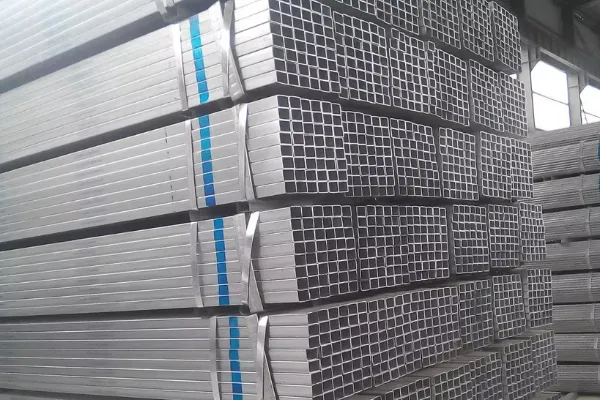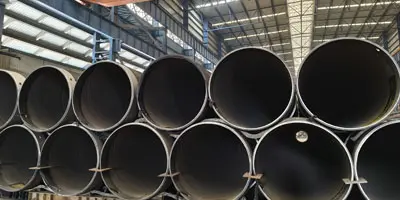The production and application of galvanized
square tubes have gradually established corresponding methods after many years of social experience. Cold-dip galvanized tubes have gradually withdrawn from the stage of application due to product shortcomings. Hot-dip galvanized steel pipes are made by reacting molten metal with iron substrate to form an aluminum alloy layer, so that the substrate and the coating are closely bonded. Hot-dip galvanizing is to first pickle and passivate the square steel pipe. In order to remove the impurities on the surface of the square steel pipe, after pickling and passivation, it is cleaned in an ammonium chloride or magnesium chloride solution or a mixed solution of ammonium chloride and magnesium chloride, and then sent to the hot-dip galvanizing tank. Hot-dip galvanizing has the advantages of uniform coating, strong adhesion and long service life.
The hot-dip galvanized square tube substrate undergoes complex physical and chemical reactions with the molten plating solution to form a zinc-nonferrous metal layer with a close structure that is corrosion-resistant. The aluminum alloy layer is integrated with the pure zinc layer and the square steel tube substrate, so it has strong corrosion resistance. The hot-dip galvanized layer of cold-dip galvanized square tube is an electroplating process layer, and the zinc layer and the square steel tube substrate are layered separately. The zinc layer is thin, and the zinc layer is easy to adhere to the square steel pipe substrate and fall off easily. Therefore, the corrosion resistance will be poor, so it is forbidden to use cold-dip galvanized square pipes as drainage pipes in newly built houses.
What Is a Hot-Dip Galvanized Square Tube
A hot-dip galvanized square tube is a steel tube with a square cross-section that has undergone
hot-dip galvanization. This process involves immersing the steel tube in molten zinc after surface treatment, resulting in a metallurgically bonded zinc coating. The outcome is a highly durable protective layer that significantly enhances the steel’s resistance to corrosion and environmental damage.
Advantages of Hot-Dip Galvanized Square Tubes
1. Low processing cost of hot-dip galvanized square tubes: The cost of hot-dip galvanizing is lower than that of other paint coatings.
2. Galvanized square tubes are durable: In suburban environments, the standard hot-dip galvanizing anti-rust thickness can be maintained for more than 50 years without repair; in urban or offshore areas, the standard galvanized anti-rust layer can be maintained for 20 years without repair.
3. Good reliability of galvanized square tubes: The combination between the galvanized layer and the steel is a metallurgical combination, making the zinc part of the steel surface, so the coating has good durability.
4. The coating of galvanized square tubes has strong toughness: The galvanized layer forms a special metallurgical structure that can withstand mechanical damage during transportation and use.
5. Comprehensive protection: Every part of the plated piece can be coated with zinc, even in recessed areas, sharp corners and hidden places.
6. Save time and effort: The galvanizing process is faster than other coating construction methods, and it can avoid the time required for painting on the construction site after installation.
7. Low initial cost: In general, the cost of hot-dip galvanizing is lower than that of applying other protective coatings. The reason is simple. Other protective coatings such as sandblasting and painting are labor-intensive processes, while hot-dip galvanizing processes are highly mechanized and tightly controlled in-plant construction.
8. Simple and convenient inspection: The hot-dip galvanizing layer can be tested visually and with a simple non-destructive coating thickness table.
9. Reliability: The specifications of hot-dip galvanizing are generally implemented in accordance with BS EN ISO 1461, which limits its minimum zinc layer thickness, so its anti-rust life and performance are reliable and predictable.
Performance Specifications
|
Property
|
Performance Range
|
|
Zinc Coating Thickness
|
40–120μm
|
|
Corrosion Protection
|
20–50 years (depending on environment)
|
|
Surface Hardness
|
≥250 HV (Zinc layer)
|
|
Coating Adhesion
|
Excellent; resists peeling or flaking
|
|
Bending Strength
|
Consistent with base steel properties
|

Applications Across Industries
Construction & Infrastructure: Steel frames, commercial buildings, residential support structures
Agriculture: Greenhouse frames, irrigation supports, animal enclosures
Transportation: Highway guardrails, road sign supports, rail components
Energy & Utilities: Solar panel supports, cable trays, electrical towers
Industrial Fabrication: Storage racks, machinery frames, heavy-duty platforms
Hot-Dip vs Cold Galvanized Square Tubes
|
Feature
|
Hot-Dip Galvanized
|
Cold Galvanized (Electro-Galvanized)
|
|
Coating Process
|
Immersed in molten zinc
|
Zinc applied via electroplating
|
|
Coating Thickness
|
Thick (40–120μm)
|
Thin (5–20μm)
|
|
Adhesion
|
Strong (metallurgical bond)
|
Weaker (physical bond)
|
|
Corrosion Lifespan
|
20–50 years
|
1–5 years
|
|
Recommended Use
|
Outdoor, harsh environments
|
Indoor, dry conditions
|
Why Choose Hot-Dip Galvanized Square Tubes?
If your project demands a durable, low-maintenance, and cost-effective steel solution, hot-dip galvanized square tubes are the answer. These tubes are engineered to perform in the most demanding environments while ensuring longevity, safety, and aesthetic appeal.
For optimal results, work with certified manufacturers who offer high-quality galvanization processes, in compliance with ISO and
ASTM standards, to ensure consistent coating thickness, adhesion, and product integrity.
Hot-Dip Galvanized Square Tubes Manufacturers
As a trusted square tube supplier, Baowi Steel offers high-quality galvanized products with full certifications.We provide customizable sizes, fast global shipping, and expert support for your project needs.Partner with Baowi Steel — where quality meets performance.






 English
English Español
Español بالعربية
بالعربية











 Phone :
Phone :  Whatsapp :
Whatsapp :  Email :
Email : 


